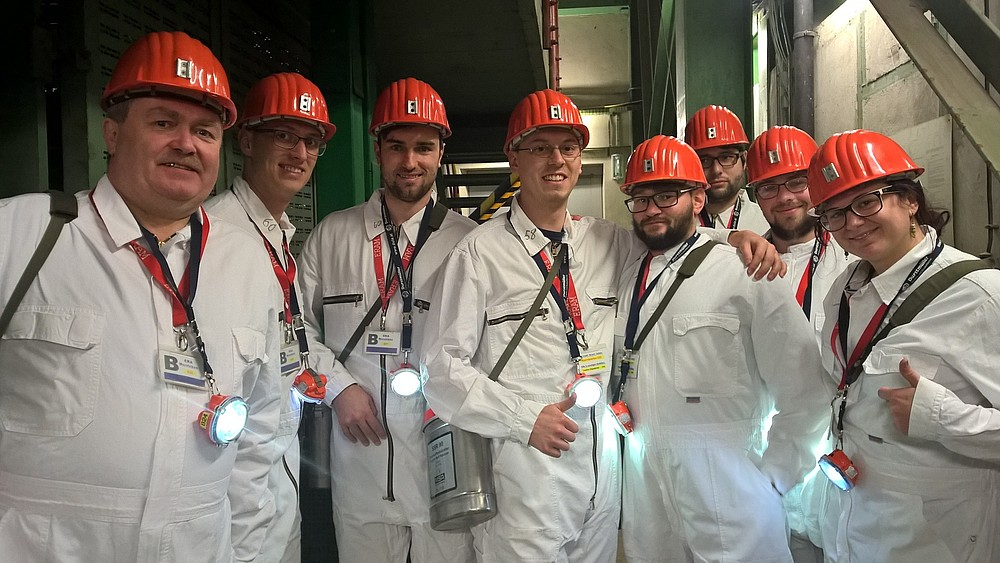The 2016 end-of-year excursion took HSZG students to Morsleben and Gorleben.

4 students from the "Energy and Environmental Engineering" degree course (specialization: Radiation and Nuclear Energy Technology) and the "Mechanical Engineering and Energy Technology" Master's degree course in the Faculty of Mechanical Engineering and 3 students from the "Ecology and Environmental Protection" degree course in the Faculty of Natural and Environmental Sciences took part in a two-day field trip/course / fieldwork.
We had to get up early, as we set off at 4:45 a.m. on 21.12.2016 in the university excursion minibus in the direction of the Morsleben repository for radioactive waste (ERAM). After a 4-hour drive, we reached our first destination - the BfS Information Center Morsleben. There we were given an introduction to the history of the salt mine, an overview of its use as a repository for low- and intermediate-level radioactive waste and the quantities stored, and were informed about the proposed decommissioning concept, which is currently undergoing the nuclear planning approval process. We were also informed about the ongoing restructuring of the current operator, the Federal Office for Radiation Protection (BfS), into the Federal Company for Final Disposal (BGE mbH).
After instructions on how to behave underground, the obligatory safety check when entering the disposal facility and the donning of protective clothing, an oxygen self-rescuer and a miner's lamp, we drove underground at a cage speed of 4 m/s accompanied by a DBE employee. We were able to experience at first hand what it looks like almost 500 meters underground in a salt dome. The main focus of the tour with diesel vehicles in the mine building was a visit to the mine surveyor's office, former underground salt mining chambers and the almost completed huge underground workshop.
After the final discussion and a visit to the exhibition in the information center, we drove on to the JH Braunschweig. As a small "cultural" contribution to the excursion, we visited the Braunschweig Christmas market in the evening.
The next morning, we went to the Physikalisch-Technische Bundesanstalt (PTB) Braunschweig - Germany's national metrology institute, in other words the highest state calibration institute in Germany. In the introductory lecture, we were given an overview of the history and tasks of the PTB and explained the new basis for the new International System of Units (SI) that will apply from 2017. This was followed by a guided tour of the historical collection of power measuring instruments used in electrical engineering and a second tour of the laboratory building of the Time Standards working group. We were introduced to the conventional cesium clocks CS1 and CS2 built at PTB with a thermal atomic beam and the modern cesium fountain clocks CSF1 and CSF2 with laser-cooled atoms, which are among the most accurate atomic clocks in the world. These atomic clocks provide the standards for time and frequency and form the basis for the national reference time scale UTC (PTB).
We quickly had to get back on our university bus, as we were already half an hour behind schedule. On the journey to the Gesellschaft für Nuklear-Service mbH (GNS) in Gorleben, we were only able to grab our lunch while "flying past" a well-known fast-food establishment. Mr. Lutz Oelschläger, who himself studied nuclear power plant engineering at the Technical University of Zittau from 1985 onwards and has been plant manager at the Gorleben interim storage facility since 2008 after holding several positions at GNS, welcomed us personally at the GNS information building in Gorleben. We visited the exhibition in the information building with exhibits on the interim storage of heat-generating highly radioactive waste. There was also a large cloud chamber in operation, which gave us a good visualization of naturally occurring radioactivity in the environment. After a short drive to the plant site and the obligatory security check, we were divided into two groups. One group was given information about safety experiments for CASTOR casks in a video room, while the other group was given a guided tour of the transport cask storage facility with just such casks.
After the many impressions of this second excursion day, we now "only" had to make our way home. Unfortunately, the weather and the traffic were not so kind to us, so that the last participants were only able to get off in Zittau after a 6-hour minibus ride.
Quotes from the students' excursion reports:
"Both Morsleben and Gorleben were impressive storage sites and the care in each case could not have been better. Personally, I was most impressed by the Gorleben interim storage facility. The costs were reasonable and the accommodation was very good. Despite the long journeys, I would go on the excursion again at any time and can only recommend it to anyone, even if they are not a nuclear enthusiast."
"The tour of the mine was the highlight of the first day of the excursion and offered spectacular impressions."
"The part of the excursion when we were in Morsleben was awesome! Especially the trip underground. The salt tastes great, by the way....The PTB in Braunschweig was less interesting. The atomic clocks were even better than the exhibition on electricity meters."
"I was surprised by the size of the mine and the strict regulations that the operators have to adhere to, as it is not only a medium-level radioactive repository, but is also operated in accordance with mining law. I have memorized the following sentence from our guides: "What is not expressly permitted is prohibited"."
"The excursion offered a varied and very interesting program. The highlights were the entrance to the salt dome in Morsleben and the visit to the Castors in Gorleben. It is highly recommended and probably a unique opportunity to gain an insight into the storage of radioactive materials."
"All three tours were interesting, it was very well organized and the supervisors were able to answer any questions that arose to the best of their ability. For me personally, the mine and the interim storage facility were the highlights."